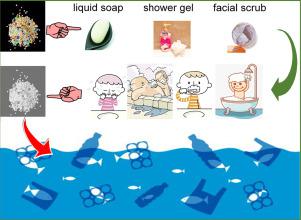Science of the Total Environment ( IF 8.2 ) Pub Date : 2020-06-22 , DOI: 10.1016/j.scitotenv.2020.140218 Qing Sun 1 , Shu-Yan Ren 1 , Hong-Gang Ni 1

|
Microplastic had been commonly used in personal care products (PCPs) until it was documented to be a pollutant. The relative contents of microplastics in PCPs decrease in the order of the USA, Europe, and Asia. The geometric means of the abundance and mass of microplastics found in PCPs were 2162 particles/g and 0.04 g/g, respectively. Diameters of PCP-derived microplastics are less than 350 μm. To quantify the exact contribution of PCPs to microplastic pollution, this review surveyed the existing scientific literature and statistically integrated the findings from 88 literatures. Overall, approximately 1500 tons/year of microplastics from PCPs escape from WWTPs and enter the global aquatic environment. According to the PCP consumption and microplastics levels, the mass emission of global PCP-derived microplastics reach up to 1.2 × 104 tons/year. The two figures account for ~0.1% and ~ 0.8% of the annual global release of primary microplastics in the world oceans (~1.5 × 106 tons/year). In the last 50 years (1970–2019), up to 3.00 × 105 tons of PCP-derived microplastics have accumulated in the environment. The main plastic in PCPs is polyethylene, which is known for being a remarkably resistant polymer to degradation. Even if microbeads are completely banned globally in 2020, microplastics that have been discharged into the environment will still persist for a long time and claim our highest attention. This review provided primary information to deal effectively with the problem of PCP-derived microplastic both now and in the future.
中文翻译:

个人护理产品中微塑料的发生率:塑料污染的相当一部分。
在证明其为污染物之前,微塑料已广泛用于个人护理产品(PCP)中。PCP中微塑料的相对含量按美国,欧洲和亚洲的顺序降低。在五氯苯酚中发现的微塑料的丰度和质量的几何平均值分别为2162颗粒/ g和0.04 g / g。PCP衍生的微塑料的直径小于350μm。为了量化五氯苯酚对微塑料污染的确切贡献,本篇综述调查了现有的科学文献,并对88篇文献的发现进行了统计整合。总体而言,每年有约1500吨PCP的微塑料从污水处理厂逸出并进入全球水生环境。根据五氯苯酚的消费量和微塑料的含量,全球五氯苯酚衍生的微塑料的质量排放量高达1.2×104吨/年。这两个数字分别占世界海洋中初级微塑料年度全球释放量的〜0.1%和〜0.8%(〜1.5×10 6吨/年)。在过去的50年中(1970-2019年),环境中积累了多达3.00×10 5吨PCP衍生的微塑料。五氯苯酚中的主要塑料是聚乙烯,众所周知,它是一种非常耐降解的聚合物。即使在2020年全球完全禁止使用微珠,已经排放到环境中的微塑料仍将持续很长时间,并引起我们的高度重视。这篇综述提供了主要信息,可以有效地解决现在和将来源自PCP的微塑性问题。











































 京公网安备 11010802027423号
京公网安备 11010802027423号